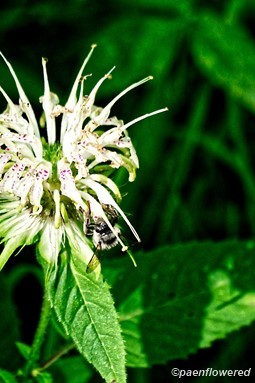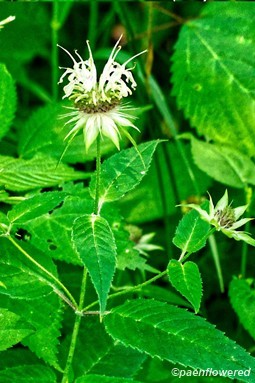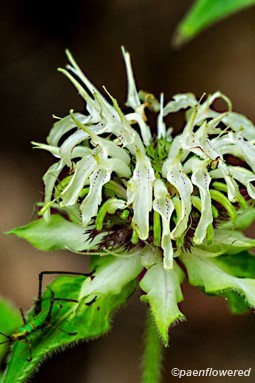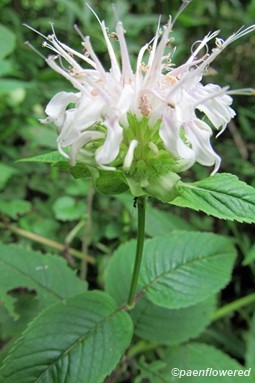Monarda clinopodia
Monarda clinopodia basil beebalm
Basil beebalm resembles other beebalms in form, except for its white or cream-colored flowers and green bracts tinged with white or pink. Small purple spots may appear on the lower lip of the flower. Like the others, it prefers full sun or partial shade and is often found in thickets or along woodland edges. The individual flowers are tubular and pollinated by long-tongued bees, butterflies, or hummingbirds. It blooms in midsummer, typically from June to July.
Basil beebalm is a clumping, fast-growing plant reaching 2-4 feet in height, often forming asexual colonies through spreading root systems. It is most visually striking when grown into large colonies with many stalks blooming simultaneously.
The leaves are simple, opposite, two leaves per node along the stem, with an aromatic smell that repels deer, typically measuring 2½ to 4¾ inches long. Leaves are widely used for tea and cooking; Native Americans also used the leaves medicinally. Like other members of its genus, the leaves can be steeped alone or blended into herbal teas.
The stems and petioles may be tinged red, with the coloration sometimes extending along the midrib. This species is less common than other Monarda species, but shares many of their ecological and cultural qualities.
Habitat & Range
Frequent in moist woods, fields, forest edges and floodplains. Prefers full sun to partial shade and moist, well-drained soil. Tolerates sandy to clay soils.
Present throughout the state.
Range: Native to eastern and midwestern United States, including Pennsylvania, ranging north from New York, west to Missouri, and south to Georgia and Alabama.
| EMP: | FACU |
|---|---|
| NCNE: | FACU |
Phenology
Flowers June to July.
Characteristics
Inflorescence one head-like cluster in axils of upper leaves or terminal on the branches; subtended by leaf-life green bracts tinged with white or pink; flower heads dense, round, solitary, 0.5 -1.2″ across
Flowers corolla white to yellowish white; tubular, two-lipped, lower lip purple-spotted; 2 (rarely 1) stamens extending beyound corolla tube; subtended by bractlets
Leaves simple, opposite, ovate to lanceolate; serrate, acuminate, rounded at base; reddish petioles; 2½ to 4¾″ long
Stems square, green to reddish, smooth to sparsely pubescent
Fruit 4 brown dry, indehiscent nutlets per flower, enclosed into a persistent calyx; 1 seed per nutlet
Height 2-4 feet, avg. 3 feet; similar spread
Plant Codes
S-rank: S5 (Secure)
G-rank: G5 (Secure)
Ecology
Minty leaves repel deer. Pollinated by long-tongued bees, butterflies, or hummingbirds. Flowers also attract ants, beetles and aphids.

.l.jpg?v=638487081480000000)







Comments
Have you spotted this plant in your area? We'd love to hear about your experience! Share your comments or questions about the plant below. Comments are moderated before posting.